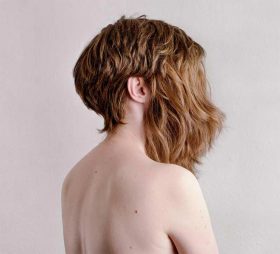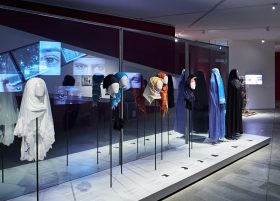Our visitors on Cherchez la femme
For over three months, the exhibition Cherchez la femme has allowed visitors to explore the topic of women’s head coverings in three of the world’s major religions. Among other things, the exhibition demonstrates that the borders of (religious) clothing rules are constantly being redrawn and reinterpreted.
Since we’re very interested in the opinions of our visitors, we asked around about what people thought at the exhibition:
Christian (39), Ludwigsburg, pastor, teaches German and history
Which object did you like the best?
The gallery with the different kinds of head coverings. I was impressed by the attention to detail. For example, I didn’t know how many differences
there were between headscarves, between Turkish and Arab styles.
What significance does your own hair have to you?
It’s important to me that I look good. I go to the barber regularly.
Would you say that you follow any clothing rules?
Yes, for example, I wouldn’t wear shorts when delivering a sermon to the congregation. That would be inappropriate.
Please describe the exhibition in three words:
Informative, unexpected, rich in variety.
Hagar (17), Italy, student
Which object did you like the best?
I thought the world map was fascinating. On the one hand, it makes me a bit sad that you’re not allowed to wear a headscarf in certain countries. On the other hand, it’s nice to see that in many countries you can practice your religion without having any problems.
Had you already engaged with the exhibition topic before?
No matter where you’re from, you’re confronted with this topic. Three years ago, I started to wear a headscarf in the Arab style. Sometimes when I’m in a public place in Italy, people come up to me and say, “Take that off. You’re not in a country where many people wear it.” They think that at some point I was forced to wear a headscarf, but that’s not true. I decided to wear it myself.
What does hair mean for you in general?
I think that every kind of hairstyle suggests a certain personality.
Please describe the exhibition in three words:
Fascinating, educational, approachable.
Shay (26), New York, studies sociology
Which object did you like the best?
The three mannequins wearing different religious bathing suits. It was interesting to see the commonalities between Judaism, Christianity, and Islam. I wasn’t so aware of that before.
Had you already engaged with the exhibition topic before?
No. Where I live, I don’t see so much religious life out on the street.
What significance does your own hair have to you?
Hm, I’d never thought about it…femininity maybe?
Do you feel that your gender played a role in your perception of the exhibition?
Yes, I think that as a woman I feel connected to the experiences and stories of women.
Monika (71), Brandenburg, engineer
What object are you looking at right now?

Covered
Anna Schteynshleyger (born 1977)
Des Plaines, Illinois, USA 2006, pigment print
Courtesy of the artist
A photograph by Anna Steynshleyger titled Covered. The lower half of the subject’s hair is longer and covers a large part of their face. Only their ear is exposed, very vulnerable. I find it moving. You don’t know who or what is hidden behind the locks.
What significance does your own hair have to you?
I like it when someone has great hair. My own is nothing special. I wear it short. It’s practical and good for cycling.
Which piece in the exhibition fascinated you the most?
The YouTube video that showed the different methods for putting on a headscarf was captivating. You have to be really skillful. Besides, there are great fabrics and patterns.
Matthieu (21), Strasbourg, studies engineering and jazz
Which object did you like the best?
The video installation titled Blicke/The Gaze. You see close-ups of the human eye on six screens.
Why did you find it so interesting?
The details. Pupils that contract when light falls across the eyes. Imperfections in the skin, wrinkles, pores emitting sweat. Not knowing who you’re looking at sometimes. A man? A woman? Since we only get to see part of the face, it’s not possible to assign them to a category.
Did the exhibition change your mind about the topic of religious head coverings?
It didn’t change my mind, but I learned more about it. Worldwide legal regulations regarding religious clothing are plotted out on the big map at the back of the exhibition. I didn’t realize just how extremely wide-ranging it was. I’m from France, and I was shocked to learn that my country is among the most restrictive on this subject.
What significance does your own hair have to you?
When I was 17, I started losing my hair. That was terrible for me. As a teenager, I wore my hair to my shoulders. It was a part of me, and I didn’t want to accept that maybe that wouldn’t always be the case. At some point, my brother put an end to the whole business. After a long night in a bar, he simply shaved my hair off.
Please describe the exhibition in three words:
Elegant, open, striking.
***
The interviews were conducted by Franziska Schurr and Florian Schmeling, neither of whom had thought much about their hair previously. One thing that they both like about Cherchez la femme is that an exhibition can lead you to new questions.
Since the duration of the exhibition has been extended, you have the chance to form your own impression of Cherchez la femme until August 27th.
You can find more information about the exhibition and on the topic of head coverings at our website: https://www.jmberlin.de/ausstellung-cherchez-la-femme
